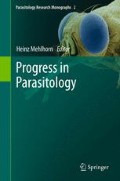Abstract
Ticks transmit a number of pathogens to humans and animals. Among them, the most important arboviral human disease in Central Europe and Northern Asia is tick-borne encephalitis (TBE). The Western subtype of TBE virus (TBEV) in Central Europe is mainly transmitted by the tick Ixodes ricinus. The incidence and the numbers of human cases are thought to be correlated to tick activity. Two different, but closely located TBEV endemic foci in South Eastern Germany were studied. The results of our longitudinal studies in both foci showed that the areas, where positive ticks could be repeatedly detected, were relatively small in comparison to earlier descriptions. The data of two endemic foci of TBEV imply that the natural circulation of TBEV between ticks and rodents or other small mammals occurs in rather small areas, named microfoci. From these microfoci, TBEV-bearing ticks are dispersed eventually, probably by larger forest animals with a greater radius of activity than rodents. Human infection occurs if humans enter the microfocus area or if infected ticks are dispersed and occasionally come into contact with humans, for example in gardens near forests or on forest ways within the area of activity of the larger forest animals, named macrofocus or endemic area. Further studies are needed to show whether this concept of TBEV microfocus and TBEV macrofocus will also apply to other endemic areas such as for example in Southwestern Germany.
Access this chapter
Tax calculation will be finalised at checkout
Purchases are for personal use only
References
Aspöck H (1970) Das synökologische Beziehungsgefüge bei Arboviren und seine Beeinflussung durch den Menschen. Zbl Bakt I Orig 213:434–454
Dobler G, Essbauer S, Wölfel R, Pfeffer M (2005) Interaktionen von Ökologie und Epidemiologie am Beispiel der Frühsommer-Meningoenzephalitis. In: Bayerische Akademie der Wissenschaften, Rundgespräche der Kommission der Ökologie. Band 28: Zur Ökologie der Infektionskrankheiten. Verlag Dr. Friedrich Pfeil, München, pp 43–52
Ecker M, Allison SL, Meixner T, Heinz FX (1999) Sequence analysis and genetic classification of tick-borne encephalitis viruses from Europe and Asia. J Gen Virol 80:179–185
Eisen L (2008) Climate change and tick-borne diseases: a research field in need of long-term empirical field studies. Int J Med Microbiol 298(S1):12–18. doi:10:1016/j.ijmm.2007.10.004
Gray JS (2008) Ixodes ricinus seasonal activity: implications of global warming indicated by revised tick and weather data. Int J Med Microbiol 298(S1):19–24. doi:10:1016/j.ijmm.2007.10.005
Kupca AM, Essbauer S, Zoeller G, de Mendonca PG, Brey R, Rinder M, Pfister K, Spiegel M, Doerrbecker B, Pfeffer M, Dobler G (2010) Isolation and molecular characterization of a tick-borne encephalitis virus strain from a new tick-borne encephalitis focus with severe cases in Bavaria, Germany. Ticks Tick-borne Dis 1:44–51. doi:10.1016/j.ttbdis.2009.11.02
Labuda M, Nuttall PA, Kozuch O, Eleckova E, Williams T, Zuffova E, Sabo A (1993) Non-viremic transmission of tick-borne encephalitis virus: a mechanism for arboviral transmission in nature. Experientia 49:802–805
Labuda M, Kozuch O, Lysy J (1997) Tick-borne encephalitis virus natural foci in Slovakia: ticks, rodents and goats. In: Süss J, Kahl O (eds) Tick-borne encephalitis and Lyme-Borreliosis. 4th International symposium on tick-borne diseases. Pabst Science Publishers, Lengerich, pp 34–46
Loew J, Radda A, Pretzmann G, Groll E (1963) Untersuchungen in einem Naturherd der Frühsommer-Meningoenzephalitis (FSME) in Niederösterreich. 1. Mitteilung: Ökologie und Saisondynamik von Ixodes ricinus. Zentralbl Bakteriol Orig 190:183–206
Loew J, Radda A, Pretzmann G, Studynka G (1964) Untersuchungen in einem Naturherd der Frühsommer-Meningoenzephalitis (FSME) in Niederösterreich. 4. Mitteilung: Ergebnisse der ökologischen Untersuchungen an einer Population von Ixodes ricinus im Jahre 1963. Zentralbl Bakteriol Orig 194:133–146
Niethammer J, Kapf F (1978) Handbuch der Säugetiere Europas, vol 2/I, Nagetiere II. Akademische Verlagsgesellschaft, Wiesbaden
Nosek J, Kozuch O, Mayer V (1978) Spatial distribution and stability of natural foci of tick-borne encephalitis virus in Central Europe. Sitzungsberichte Heidelberger Akad Wiss 1978(2):60–74
Pretzmann G, Loew J, Radda A (1963) Untersuchungen in einem Naturherd der Frühsommer-Meningoenzephalitis (FSME) in Niederösterreich. 3. Mitteilung: Versuch einer Gesamtdarstellung des Zyklus der FSME im Naturherd. Zentralbl Bakteriol Orig 190:299–312
Pretzmann G, Radda A, Loew J (1964) Untersuchungen in einem Naturherd der Frühsommer-Meningoenzephalitis (FSME) in Niederösterreich. 5. Mitteilung: Weitere Untersuchungen des Viruskreislaufes im Naturherd. Zentralbl Bakteriol Orig 194:431–439
Radda A, Loew J, Pretzmann G (1963) Untersuchungen in einem Naturherd der Frühsommer-Meningoenzephalitis (FSME) in Niederösterreich. 2. Mitteilung: Virusisolierungsversuche aus Arthropoden und Kleinsäugern. Zentralbl Bakteriol Orig 190:281–298
Radda A, Kunz C, Hofmann H (1968) Nachweis von Antikörpern in Wildseren zur Erfassung von Herden des Virus der Frühsommer-Meningo-Enzephalitis (FSME) in Niederösterreich. Zentralbl Bakteriol Orig 208:88–93
Randolph S, Gern L, Nuttall PA (1996) Co-feeding ticks: epidemiological significance for tick-borne pathogen transmission. Parasitol Today 12:472–479
Randolph S, Green RM, Peacey MF, Rogers DJ (2000) Seasonal synchrony: the key to tick-borne encephalitis foci identified by satellite data. Parasitology 121:15–23
Süss J, Schrader C, Falk U, Wohanka N (2004) Tick-borne encephalitis (TBE) in Germany – Epidemiological data, development of risk areas and virus prevalence in field-collected ticks and in ticks removed from humans. Int J Med Microbiol 293(suppl 37):69–79. doi:1433-1128/04/293/Suppl.37-69
Author information
Authors and Affiliations
Corresponding author
Editor information
Editors and Affiliations
Rights and permissions
Copyright information
© 2011 Springer-Verlag Berlin Heidelberg
About this chapter
Cite this chapter
Dobler, G., Hufert, F., Pfeffer, M., Essbauer, S. (2011). Tick-Borne Encephalitis: From Microfocus to Human Disease. In: Mehlhorn, H. (eds) Progress in Parasitology. Parasitology Research Monographs, vol 2. Springer, Berlin, Heidelberg. https://doi.org/10.1007/978-3-642-21396-0_17
Download citation
DOI: https://doi.org/10.1007/978-3-642-21396-0_17
Published:
Publisher Name: Springer, Berlin, Heidelberg
Print ISBN: 978-3-642-21395-3
Online ISBN: 978-3-642-21396-0
eBook Packages: Biomedical and Life SciencesBiomedical and Life Sciences (R0)

